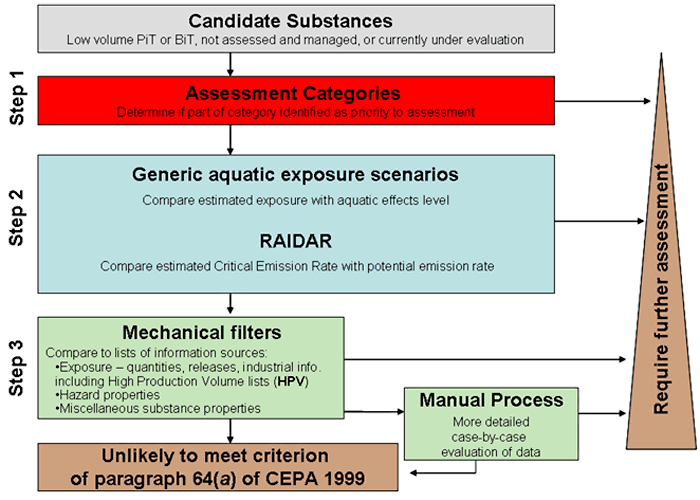Rapid screening of substances of lower ecological concern: results
Official title: Rapid screening of substances of lower ecological concern
Results of the ecological screening assessment
Existing Substances Division
Environment Canada
March 20, 2007
Table of contents
- Legislative context
- Summary of the rapid screening approach
- Substances covered under this assessment
- Assessment of toxic under paragraph 64(a) of CEPA
- Summary of results
- Conclusion
- Uncertainties and further activities
- References
- Appendix A: number of substances flagged by each mechanical filter and resulting path
- Appendix B: substances that require further assessment
- Appendix C: substances not meeting the criterion under paragraph 64(a) of CEPA
Legislative context
During the categorization of substances on the Domestic Substances List (DSL), Environment Canada has identified a subset of the substances meeting the criteria set out under paragraph 73(1)(b) of the Canadian Environmental Protection Act, 1999 (CEPA) that are expected to have a low likelihood of causing harmful ecological effects, as it is believed that low volumes are in commerce.
Environment Canada has developed a pragmatic approach to conducting a screening assessment under section 74 for substances that have a low likelihood of meeting the criterion set out in paragraph 64(a) of CEPA. Under paragraph 64(a), a substance is considered "toxic" if it is entering or may enter the environment in a quantity or concentration or under conditions that have or may have an immediate or long-term harmful effect on the environment or its biological diversity.
This assessment presents the results of application of this technical "rapid screening" approach to 1066 substances that are persistent and inherently toxic to non-human organisms (PiT(eco)) or bioaccumulative and inherently toxic to non-human organisms (BiT(eco)), and that are believed to be in commerce in Canada at a maximum of 1000 kg per year across the country.
Summary of the rapid screening approach
The rapid screening approach uses a series of both qualitative and conservative quantitative steps to efficiently evaluate the likelihood that a substance may cause ecological harm. At each of the steps shown in Figure 1, substances for which there may be potential to cause harm are identified as requiring further screening assessment beyond the rapid screening approach. For those substances that proceed through all steps of the approach without being thus identified, it is concluded that they are unlikely to cause ecological harm and, as such, do not at this time meet the criterion set out in paragraph 64(a) of CEPA.
Figure 1: overview of the rapid screening approach
Figure 1: Overview of the rapid screening approach

Long description for figure 1
Steps describing figure 1 are identified in the text below.
The first step consists of determining if substances belong to categories that have been identified for evaluation as part of a category assessment. These substances are identified at this step as requiring further screening assessment beyond the rapid screening approach, and do not proceed to step 2.
The second step involves applying different exposure scenarios through the use of environmental fate models. First, two generic aquatic exposure scenarios are considered to identify potential concerns near the point of discharge of a substance to the environment. A regional multi-media model named RAIDAR (risk assessment, identification and ranking) is also applied to identify potential concerns in different environmental media, as well as in food chains.
The third step involves a mechanical process to identify whether or not a substance appears on different lists or in sources of information relating to hazard or exposure (including quantity in commerce). This flags substances that have been identified by domestic or international initiatives as being of greater concern due to their hazard properties, or which may now be in commerce at greater quantities than is believed to be the case based on the available information.
Depending on the nature of the information sources, substances flagged by the mechanical process may be concluded as requiring further assessment beyond rapid screening, or may be further evaluated within rapid screening using a "manual process". The latter involves case-by-case evaluation to decide, for example, whether the information in the source that flagged the substance is relevant to the situation in Canada. This may also involve collection and review of information from other sources that are not as amenable to evaluation using a mechanical approach. The manual process involves evaluation of the weight and relevance of information obtained from the full range of sources identified.
A detailed description of the approach is contained in a separate document (Environment Canada, 2007a).
Substances covered under this assessment
Substances identified for rapid screening under this assessment are those nominated to the Domestic Substances List (based on quantities imported, manufactured or otherwise in commerce in Canada in 1986) at total quantities ≤ 1000 kg across the country. Since quantities were reported as ranges, the quantity representing the upper boundary of the reported range was used. If the sum from all notifiers exceeded 1000 kg, the substance was not considered as a candidate for this assessment. Therefore, substances reported in the range 0-100 kg by 10 or fewer companies are included, as well as substances reported in the range 100-1000 kg by a single company.
The substances being assessed have also been identified as PiT(eco) or BiT(eco) through the categorization process. Those substances that were identified by categorization as being PBiT (substances that are persistent and bioaccumulative and inherently toxic to non-human organisms) are excluded from consideration under this assessment, due to particular concerns identified for substances having this combination of properties.
Substances that meet the above criteria, but that have already been assessed and managed under CEPA, are not included. Some other substances have not been included as they are either currently undergoing evaluation or have been identified as priorities for assessment from a human health perspective.
This document reports the results of rapid screening of the 1066 substances that meet the above criteria.